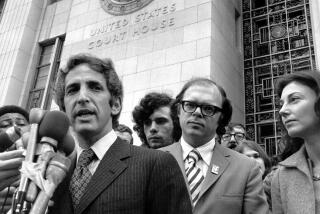Adams Case Centers on ‘Lost’ Negatives
- Share via
Ansel Adams incorrectly told U.S. Department of the Interior officials that negatives for pictures featured in a new book of his work had been destroyed in a fire when, in fact, they were housed in his vault, new court documents charge.
Moreover, the vice president of a publishing company defending itself in litigation over the book contended in an affidavit filed in U.S. District Court earlier this week that a wide variety of what may be some of Adams’ most famous pictures “would be the property of the U.S. government.”
Adding to contentions originally made in an interview with The Times, John Diamond asserted in the court filing that “many more of Adams’ photographs than was originally suspected are in the public domain.” Diamond referred to photographs Adams took while working as a government employee but which Adams had stipulated to be part of his private work.
The allegation that Adams gave government officials incorrect information on the fate of the negatives for the Mural Project, a series of 225 images of national park scenes that Adams shot in 1941 and 1942, is contained in documents filed by Day Dream Publishing, Inc.
The company is the chief defendant in the federal court suit filed in Los Angeles earlier this year by the Ansel Adams Publishing Rights Trust. The trust is seeking an injunction to prevent Day Dream from capitalizing on Adams’ name in promotion of its book, “The Mural Project,” a photographic anthology of 85 of the national park images. Day Dream also seeks to publish wall calendars and date books using the disputed photographs.
Day Dream and the book’s two authors assembled the volume using copies of prints made by Adams from the original negatives. The 226 prints are part of the public-domain collection of the National Archives and copies are available to anyone willing to pay fees averaging about $10 per photograph.
The fate of the Mural Project negatives has emerged as a central issue in the federal court litigation. Officials at Yosemite National Park said they attempted twice, without success, to learn from Adams the fate of the negatives in the year or so before the photographer died in 1984.
In court documents filed by the Adams publishing trust earlier this year, the photographer’s estate revealed that the negatives are in the trust’s custody, housed in Adams’ personal vault on the grounds of his home in Carmel Highlands, Calif.
But Day Dream charged in the new court documents that Adams told Interior Department officials that the negatives had been lost in a fire. And on Friday, Jill Brett, a National Park Service spokeswoman in Washington, confirmed that Adams discussed the destruction of the negatives in a visit to Washington with his wife, Virginia, in 1979.
Brett said Adams had come to Washington to inspect the surviving Mural Project prints. The photographs were commissioned for anticipated mural-size display in Interior Department buildings. The huge enlargements were never executed, however, and only a set of conventional-sized prints, made by Adams himself, have remained.
According to a 1979 Interior Department employee newsletter that published an account of Adams’ visit, the photographer told officials the negatives were destroyed in a fire in 1937--four to five years before the photographs were actually made.
In his affidavit, Diamond charged Adams and his trust engaged in “a deception that is ongoing and prolonged.” However, David Vena, a Los Angeles lawyer who is one of the Adams trustees, responded Friday that Adams was notorious for his inability to remember dates--a foible to which Adams alludes in his autobiography to explain his ascribing at least four different dates to his most famous image, “Moonrise, Hernandez, N.M.,” shot in 1941.
Vena said the trust is not certain whether all or only some of the mural project negatives are in the Adams vault. He said a detailed comparison of the prints in the National Archives with negatives in the vault would have to be made since Adams made several similar shots of each image.
The similarity of images in question is pertinent to the dispute over whether other Adams photographs should be considered in the public domain. In his correspondence and employment arrangements with the Interior Department, he stipulated he would mix his government photographing with his private work.
Thus, one of his most famous pictures, “White House Ruin, Canyon de Chelly National Monument, Ariz.,” made in 1942, is almost identical to an image in the government collection and published in the new book.
Vena said there is no doubt that some prints made by Adams in his lifetime that are now highly valued on the art photography market were, in fact, made from Mural Project negatives. He said the question is not relevant to the dispute over publication rights and rights to use Adams’ name and reputation in connection with promotion of the unauthorized book.
More to Read
Sign up for our Book Club newsletter
Get the latest news, events and more from the Los Angeles Times Book Club, and help us get L.A. reading and talking.
You may occasionally receive promotional content from the Los Angeles Times.









